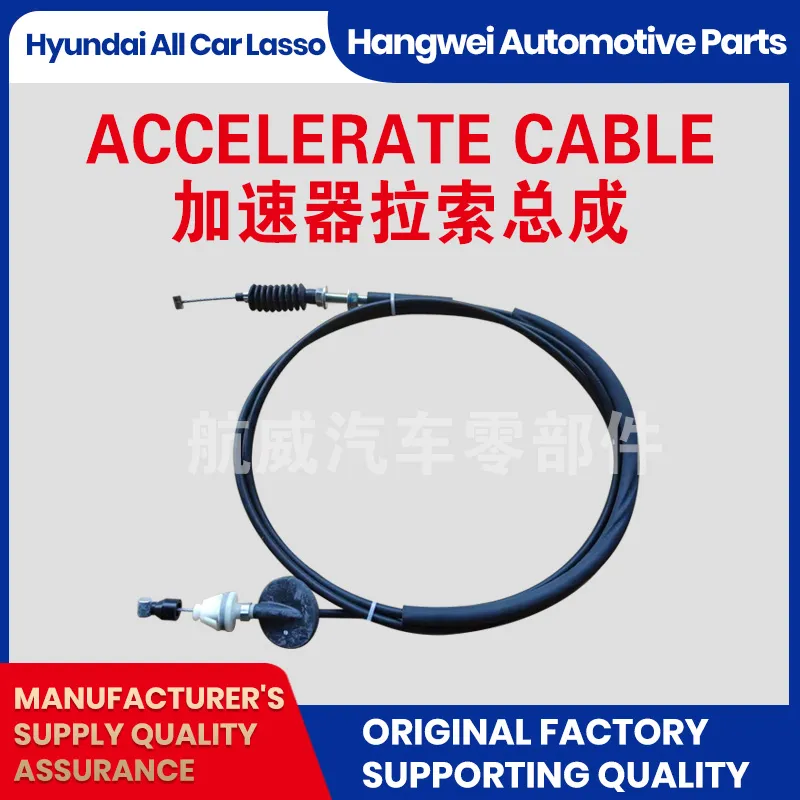Adjustable Universal Throttle Cable — Smooth, Durable
Accelerator Push-Pull Cable: an insider’s take on modern control links
When people talk about a Throttle Cable, they usually picture a simple Bowden cable pulling a butterfly valve. In practice, the best assemblies today—like the Accelerator Push-Pull Cable from Qinghe County (Minjiang Street south, Wuzhishan Road east)—are engineered systems: multi-strand steel cores, low-friction liners, robust end fittings, and very specific test regimes. And yes, despite drive-by-wire trends, demand is steady in motorcycles, off-road, marine, lawn & garden, and industrial engines. Actually, it’s growing in niche EV auxiliaries too (think generators and small power units).

What sets a modern Throttle Cable apart
Materials and methods matter. A typical build uses galvanized or stainless steel 7×7 or 7×19 strand, a PTFE or PA12 liner, and an extruded HDPE/PA outer jacket. Terminals are swaged (zinc die-cast, brass, or 304/316 stainless), and housings get anti-kink reinforcement. Many customers say they notice smoother pedal feel after switching to a low-friction liner—unsurprising; PTFE really shows up in cold starts.
Representative Specifications (real-world use may vary)
| Core strand | 7×7 / 7×19 galvanized steel or 304 SS (≈1.2–2.5 mm) |
| Conduit & liner | Helical steel conduit with PTFE or PA12 liner |
| Outer jacket | HDPE/PA, UV stabilized (black standard) |
| Push–pull load rating | Push ≈ 60–120 N; Pull ≈ 150–400 N (depending on length/routing) |
| Operating temp | −40°C to +105°C (liner-dependent) |
| Service life | ≥300,000 cycles typical; up to ≈1,000,000 with PTFE + stainless |
| Certifications | ISO 9001, IATF 16949; RoHS/REACH compliant materials |
| Origin | Qinghe County Minjiang Street south, Wuzhishan Road east |
Process flow & testing
Design-for-routing → wire strand selection → conduit + liner assembly → jacket extrusion → end fitting swaging → 100% length check → friction/force verification → cycle rig endurance → corrosion & UV. Typical tests include 96–240 h salt spray (ASTM B117 or ISO 9227), UV aging (ISO 4892-2), and thermal cycling. One lab dataset I saw showed 500k cycles at 80 N pull with
Applications and advantages
- Automotive and light trucks (mechanical throttles, PTO rev control)
- Motorcycles/ATVs/UTVs; marine throttle/shift; lawn & garden (mowers, generators)
- Industrial engines, compressors, material handling equipment
Advantages? Predictable pedal feel, no latency, field-serviceable, and—surprisingly—cost certainty versus some sensor-driven assemblies. A well-built Throttle Cable also tolerates dirt and vibration better than many first-gen electronic throttles in harsh duty.
Customization
Options include jacket color, stainless core, sealed boots, custom end fittings (barrel, clevis, threaded), and low-friction liner upgrades. For tight engine bays, ask for bend radius analysis; routing is half the battle. Many customers say a 50 mm bend radius threshold keeps friction stable over life.
Vendor comparison (what buyers actually check)
| Vendor | Certs | Lead Time | MOQ | Notes |
|---|---|---|---|---|
| HWEI (Accelerator Push-Pull Cable) | IATF 16949, ISO 9001; RoHS/REACH | 3–6 weeks around | Low (pilot-friendly) | Robust testing, custom routing support |
| Generic Importer | ISO 9001 (varies) | 6–10 weeks | Medium–High | Price-led, limited customization |
| Local Assembler | Shop-level QA | 1–3 weeks | Very low | Fast turns, variable component traceability |
Mini case studies
Off-road UTV maker: swapped to PTFE-lined Throttle Cable with stainless core; warranty claims for sticky throttles dropped ≈42% season-over-season. Marine OEM: specified 316 SS terminals and ISO 9227 240 h corrosion target; no stuck controls after winter layups, which, frankly, saves headaches for dealers.
Buyer checklist
- Confirm load vs. length and minimum bend radius
- Ask for cycle and friction data after salt spray/UV aging
- Verify IATF 16949 and material compliance (RoHS/REACH)
- Request routing mock-up or 3D path study before tooling
Customer feedback snippet: “Pedal feel is smoother in cold mornings; no more binding near the firewall.” That matches what we’ve seen in bench tests after −30°C soaks.
Authoritative references
- ASTM B117 – Standard Practice for Operating Salt Spray (Fog) Apparatus
- ISO 9227 – Corrosion tests in artificial atmospheres — Salt spray tests
- ISO 4892-2 – Plastics — Methods of exposure to laboratory light sources
- IATF 16949 – Automotive Quality Management System; ISO 9001 – Quality Management; EU RoHS Directive; REACH
-
Clutch Line: Braided, Leak-Proof, OEM-Grade PerformanceNewsNov.10,2025
-
Throttle Cable: Durable, Smooth Control & Universal FitNewsNov.10,2025
-
Throttle Cable: Durable, Smooth, Universal Fit, Easy InstallNewsNov.10,2025
-
Clutch Line: Durable, Leak-Proof, OEM-Grade PerformanceNewsNov.10,2025
-
Hand Brake Cable | Custom, Universal & Trailer SolutionsNewsNov.10,2025
-
Clutch Line: High-Pressure, OEM-Fit, Corrosion-ResistantNewsNov.03,2025
